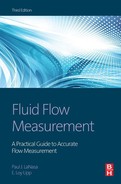Preface
As noted in the preceding Dedication, the tendency to make flow measurement a highly theoretical and technical subject overlooks a basic tenet: Practical application of meters, metering principles, and metering instrumentation and related equipment is the real key to quality measurement. And that includes the regular maintenance by trained and experienced personnel with quality equipment required to keep flow measurement systems operating so as to achieve their full measurement potential.
We cannot begin to name the many friends who make up our background of experience. They include the pioneers in flow measurement, flow measurement design engineers, operating personnel—ranging from top management to the newest testers—academic and research based engineers and scientists, worldwide practitioners, theorists, and those just getting started in the business.
Our personal experience has been that understanding creates the most complete comprehension. Standing in front of a “class” as a “student” asks for an explanation of a point just covered, quickly and clearly separates what you have learned by rote from that which you truly understand. One finds out very rapidly what one really knows. Hopefully you will find that which you need to know and understand.
Why another book on flow measurement? Several factors motivated us. We have mentioned our emphasis on the practical side of the subject. Another reason is the large number of retirements and passings of experienced measurement personnel, including ourselves. And a third consideration is the tendency to make our various measurement standards “technically defensible”—but confusing.
We felt simply that a practical guide could be a useful project.
In the material covering standards, the brief overviews are coupled with our hope that interested readers will consult the documents and organizations listed for additional information. In the same vein, detailed theoretical discussions are left to such excellent sources as the latest edition of the Flow Measurement Engineering Handbook by R.W. Miller. Because of the extent of such detailed information, we present only outlines along with reference information for the reader’s use.
We hope that enough practical information will be found in this book to help a reader analyze a flow problem to the extent that the other detailed references will become clear. We have tried to “demystify” flow measurement by breaking the subject into simple sections and discussing them in everyday terms. Each technology has its own terminology and jargon; that is why you will find many definitions and explanations of terms in the book.
In short, flow measurement is based in science, but successful application depends largely on the art of the practitioner. Too frequently we blindly follow the successful artist simply because “that is the way we’ve always done it.” Industry experience the world over shows, however, that understanding why something is done can almost always generate better flow measurement.
